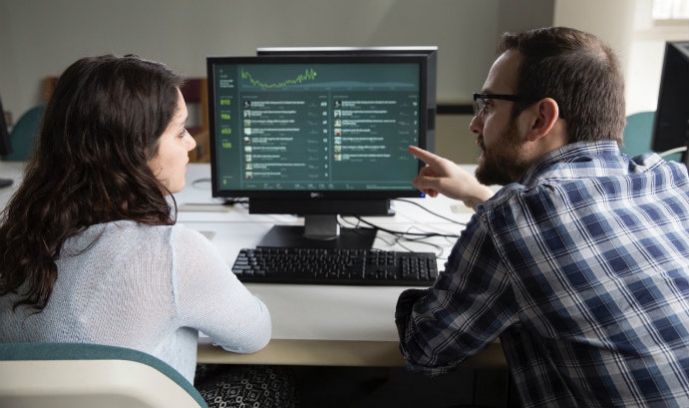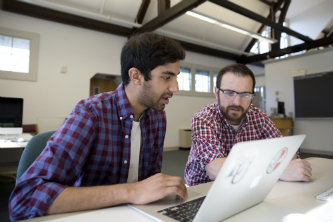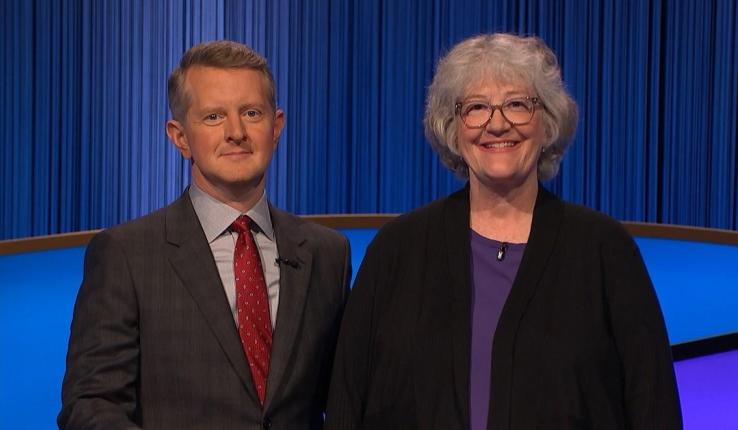'The All-stars of the Program': Lehigh and Parse.ly Partner to Support Student Data Journalism

Danielle DiStefano ’16 examines The Brown and White's Parse.ly dashboard with Matt Veto, professor of practice in Lehigh’s department of journalism and communication and faculty adviser to The Brown and White.
Last spring, Samantha Tomaszewski ’17 interviewed for a position as an associate social media editor at HuffPost. Given the data-centric nature of the job, the subject of data analytics came up. When Tomaszewski asked what software the popular news and opinion website uses, she was delighted by the answer: Parse.ly.
Parse.ly is a technology firm that provides web analytics and content optimization software for online publishers, including HuffPost; The Wall Street Journal; Time, Inc.; Slate and Mashable. And, thanks to its Parse.ly University Partnerships Program (Parse.ly U), the company provides analytics for Lehigh’s student newspaper, The Brown and White, as well. Sitting in her HuffPost interview, Tomaszewski, a former editor-in-chief of The Brown and White, found herself at a serious advantage: She already knew how to use the software.
“My face lit up, and [the interviewers] were really excited that I knew about it,” says Tomaszewski, now associate social media editor at HuffPost.
Fall 2017 marks the fifth semester that the staff of The Brown and White has participated in Parse.ly U, a program that partners the company with academic institutions with student-run publications. In exchange for free access to the full Parse.ly dashboard, which provides real-time and historical data on key metrics, the newspaper’s student editors brainstorm issues facing the newspaper, use the Parse.ly dashboard to tackle them and then write a report on their findings, which Parse.ly posts on its website and sometimes shares with its clients as use cases. Other participating universities have included the University of Missouri, Michigan State University, Northwestern University and the University of Virginia.
“This partnership has truly been a win-win,” says Matt Veto, professor of practice in Lehigh’s department of journalism and communication and faculty adviser to The Brown and White. “It gives our students access to cutting-edge software, but more importantly gets them thinking about the impact of their content well beyond ‘clicks.’”
A Unique Opportunity for Student Data Journalism
Parse.ly U began with requests from student-run newspapers with limited budgets seeking analytics for their newsrooms.
"We have an interest in training the next generation of journalists on the most innovative analytics,” says Ben Probert, senior account manager at Parse.ly and director of Parse.ly U. “But we didn’t want to drain the entire budget of a student newsroom, so we came up with the idea to start this university program. We essentially give free access to our entire full analytics suite to journalism programs and student-run newspapers. In return, instead of any money, at the end of the semester they put together a project.”
From the start, Veto set the bar high for The Brown and White staff’s Parse.ly projects.
“I wanted our students to do something a little bit more involved, especially pushing Lehigh’s Data X initiative and how important data is in journalism itself,” he says. “It’s clear that data has a very important and long-term role in how we report, and then on the back end, how we deliver our content in more effective and interesting ways. ... We want [the Parse.ly project focus] to be something that’s actionable, something that can inform our strategy for how we deliver our content to our audience.”
As a result, Lehigh students have researched a number of relevant topics, including ideal read times and story lengths for different article types, the most effective social media post times for the newspaper’s audience, the most popular story types and genres and the effect of Facebook’s algorithm on the reach and visibility of content.
“Lehigh has been our all-stars of the program,” says Probert. “Their work shows a deep and intuitive understanding of the importance of understanding an audience through data, which is something people who have been working in the industry for much longer have a harder time grasping."
In Fall 2015, Danielle DiStefano ’16, then the editor-in-chief of The Brown and White, wrote a paper for Parse.ly that explored the ideal story length for different sections of the newspaper by correlating average read time with the number of words in a story. The newspaper staff then tagged individual stories with estimated read times and used Parse.ly to determine if the length of content affected the average engagement time of different stories. DiStefano concluded in the report that “The Brown and White has a very short window to capture its audience and convey its message before readers jump off the page” and that “the results of this project indicate that while we must be strategic in how we capture our readers, that conclusion is the same across all lengths of content, not just one format.”
“That was one of the coolest projects that we had seen,” says Probert, who shared the report with all of his accounts. “That blew all of us away. We’ve just been really impressed with everything that we’ve seen since we started.”
The Importance of Analyzing Data in Journalism
Even if they aren’t involved in producing a particular semester’s research project, The Brown and White staff use the Parse.ly dashboard in making editorial decisions during weekly press nights. Each team examines the dashboard for about 20 minutes and then debriefs and shares with the larger group what they learned from the analytics and the changes they might make based on what they learned.
“It really helped to drive our content a lot, which was neat. We actually had legitimate numbers to work from. We were able to see where the traffic was coming from and why. It definitely helped us figure out our audience a bit more,” says Tomaszewski of her time on the paper.
“We wanted the whole newsroom to really start getting in the mindset of how analytics would shape the way that we pitch stories,” says DiStefano. “[We started] really getting creative and not just seeing it as, ‘Oh, we got a thousand views on this story and that’s great.’ [We were] using it as a way to be more proactive about the stories that we were writing for our audience.”
Austin Vitelli ’17 always had an interest in following the stats to see which Brown and White articles did well and which didn’t.
“I was really excited when we could get some really detailed analytics of what our readership was [with Parse.ly],” Vitelli says. “I was sports editor at the time, and each section editor had to take over their section’s analytics and be tracking them each week. We had to meet briefly at the beginning of each of our Wednesday press nights with our sections and discuss what we thought about the results from the past week and talk about ways that we might improve them. So kind of right off the bat I was asked to lead some of those discussions. … I think just because I enjoyed it so much, I kind of stuck with it and tried to stay involved as much as possible.”
Vitelli looked in particular at the performance of different types of articles in the newspaper to determine whether the paper should increase or decrease a certain type of article. The sports section, for example, included game recaps, and the team decided to experiment with the length and style of that type of story.
Musa Jamshed ’19, an assistant sports editor at the time, suggested that they shorten the recap structure and break it up into sections.
“We noticed [through Parse.ly] that people were reading [the shorter recaps] a little more frequently than other recaps, even though it might have been for a sport that we knew wasn’t going to get as much readership,” says Vitelli. “Once we figured out that maybe it would actually have an impact if we start to switch things up, we started to do fewer game previews because we realized that generally those weren’t getting as many views as more feature-style stuff. We [eventually] started making some of our game previews a little bit more feature-y … [and] focused in on some angle and ran with that as the focus as opposed to the actual game, and that was doing really well. It wasn’t that surprising that people preferred a feature-y angle; it was just something that we hadn’t really thought of to do regularly until we started [using Parse.ly].”
“I think with Parse.ly there were more opportunities for us to think broadly across what The Brown and White was writing about in general. And I think it got people pitching stories for other sections, which didn’t happen often before. It got us thinking more broadly and comprehensively across the whole newsroom and the whole team, and there’s no arguing that that’s great for The Brown and White in general,” says DiStefano.
Marketable Skills for Data Journalism Jobs and Beyond
Tomaszewski saw her experience with Parse.ly transfer directly into a marketable skill that helped her get a job.
Like Tomaszewski, Vitelli also mentioned his use of Parse.ly while interviewing for his current position as an assistant editor at a medical publishing company. His experience doing data analytics for The Brown and White enabled him to take that on as part of his job: He now reports website and ad traffic for the company.
“I wouldn’t have had that opportunity to do that if I hadn’t gotten to work with Parse.ly,” he says. “Even though I’m not going out and reporting on stories anymore, I’m still taking a lot of the same skills that went with The Brown and White, even beyond the stuff I learned with Parse.ly, and now I’m getting to apply it in a somewhat adjacent but also different field, and that’s been really rewarding.”
DiStefano, who now works in marketing for a management consulting firm, adapted the skills she acquired doing data analytics to her work in marketing.
“Thinking like your audience instead of thinking like your business is something that’s hard to do because you get stuck in the world of jargon and business terms and the way you think internally, which isn’t necessarily the way that people are thinking about you from the audience perspective,” she says. “[Using Parse.ly], we were thinking about how readers will find us online. We were able to start thinking about SEO [search engine optimization], which is something that's valuable pretty much in any industry or company or career these days. It helps you think from the client side.”
Taking Data to the Next Level
Jamshed started working on The Brown and White because he wanted to “try something out in college, and it ended up being something I like to do a lot.” A student in the Computer Science and Business (CSB) program, he says he’s “really into data analytics.”
“I’ve learned a lot about journalism,” he says. “If I can merge this with something that I study in school and am also really passionate about, it’s going to be even better. I’m all for the data-oriented approach for anything.”
Jamshed is taking his love of analytics to a newly created role for the paper: data and graphics editor.
“As an umbrella group of people that are interested in data, one of our responsibilities will be doing more small investigative work on Parse.ly, which is great because my level of interest in it has not changed. … Now data is actually my role, my focus. … Our goal is to enhance the rest of the newsroom and push out new types of content.”
Jamshed is considering a possible career in data journalism, but, he says, “this year is going to be a pretty big test because that’s what I’m going to be doing.”
Whichever direction he takes, he says, his work on the newspaper has been beneficial.
“People ask why I spend so much time on The Brown and White,” he says. “I think career-wise it’s paid off immensely, and everyone seems to be intrigued by my interest in it. Anytime you do something that’s a little different from what you’re studying, people are interested. It’s a lot of the stuff I have to show off [in interviews], leadership positions I’ve had on the newspaper, so it’s twofold in that regard—legit work and something that helps you stand out.”
‘A Rare Opportunity’ to Learn from Other Student Journalists
Next up for Parse.ly U: a unique data-sharing program between participating schools that will allow student journalists to have access to not only their own dashboard analytics, but to those of other participating schools as well.
“There’s not really an overlapping market between the two, so there’s no competition,” says Probert. “It’s all about collaboration, learning from what’s working and what’s not from the other schools.”
“From an industry standpoint, analytics are often closely guarded and shared only internally,” says Veto. “So, it's very hard to compare your publication to a similar publication from a web analytics standpoint. Our joining this share program makes great pedagogical sense, and judging by the number of institutions that signed on, that feeling is mutual. This will allow us a rare opportunity to peek into other student news sites to see how our audience might be similar or different from another audience.”
Photos by Stephanie Veto
Posted on:





